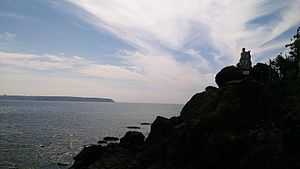Dona Paula


Dona Paula is a former village, and tourist destination, in the suburbs of Panaji, Goa, India.[1] It is today home to the National Institute of Oceanography, and just alongside it lie the Goa University and the International Centre Goa. It is also home to a number of hotels, small and large, and the luxury Cidade de Goa is situated in the area.
History

The place is named after Paula Amaral Antonio de Souto Maior, a historical figure in Portuguese India. She was the daughter of the Portuguese Viceroy of Jaffnapatnam, in Sri Lanka. She and her family arrived in Goa in 1644 and she married a Fidalgo from Spain in 1656. Her husband was Dom Antonio Souto Maior. They were an extremely affluent family, and the entire property from the present day Cabo Raj Nivas all the way to Caranzalem belonged to the Souto Maiors. She died on December 16, 1682.
Dona Paula was a woman of charity and is known to have helped the villagers and worked a lot for their betterment, so after her death, the villagers decided to re-name the village as Dona Paula. Initially the village was called Oddavell.[2]
The Dona Paula Beach is also a major tourist attraction. According to a local myth, Dona Paula entombed in the Cabo Chapel, the residence of the Governor of Goa and is supposed to be seen emerging from the moonlit waves wearing only a pearl necklace. Several tourists as well as locals guided by this myth visit the beach for a glimpse of Dona Paula. The Cabo Raj Bhavan is situated at a scenic spot of Dona Paula. It is also home of a historic British war-graves cemetery. After the end of Portuguese rule in Goa in 1961, Dona Paula became a fashionable residential area and address.
Vicinity
Dona Paula, today, is home to some of the top Industrialists of the state.
STATUE:
First Theory suggests that the alleged statue of 'Dona-Paulo.' According to Heta Pandit in her book 'Walking in Goa,' the statue seen today at the jetty in Dona Paula is in reality the sculpture of Mr.and Mrs. Robert Knox. It was a Dutch sculptor, Baroness Yrse Von Leistner who etched the sculpture as she admired the philosopher Robert Knox.
Second Theory is that the statue is of a Father (A European Gentleman... name needs to be ascertained) who is pointing to the West, indicating to his daughter, about their origins and telling her, "West is were we come from."
Tourism
Dona Paula located on the beautiful and famous sea stretch that spans from Panjim, Miramar and Dona Paula is a very famous area frequented by tourists. During the tourist season Dona Paula transforms into a crowded stretch which is otherwise a calm beautiful place during monsoons. A large part of the famous Hindi movie Ek Duuje Ke Liye was shot here, popularising the place further. An action sequence from Rohit Shetty's movie Singham was shot here. The idyllic rocky tourist attraction lies at the spot where the Mandovi and the Zuari river meet and confluences with the Arabian Sea at a distance of 1 Km from this point.